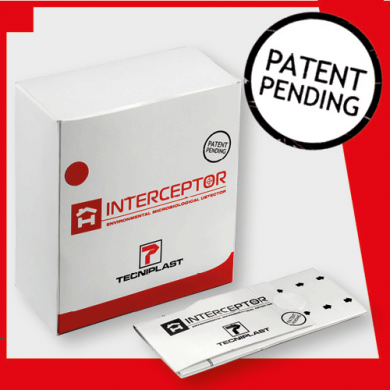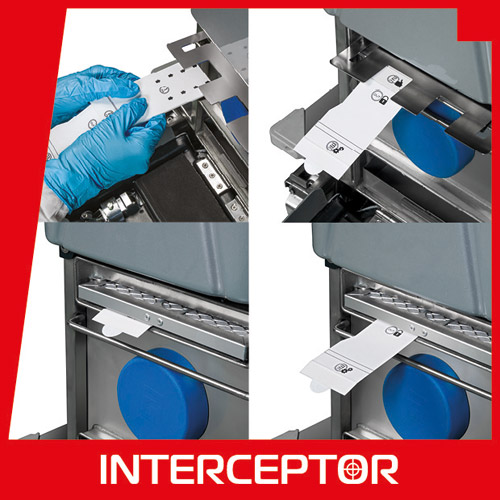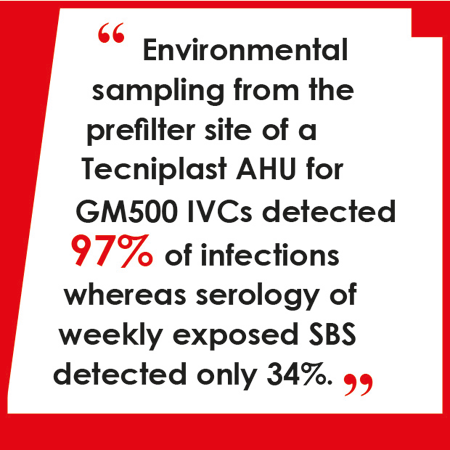
The current version of the Tecniplast website doesn't match your region. Please visit your local website to find information and offerings specific to your country.

The current version of the Tecniplast website doesn't match your region. Please visit your local website to find information and offerings specific to your country.


The solution Tecniplast presented is an accurate environmental microbiological monitoring in IVCs, which represent a new frontier to monitor the hygienic state of laboratory animals with a highly sensitive solution for the collection of contaminated dust particles. In addition, the removal of biological samples from the IVC occurs in a contamination-free manner enabling the safe transfer of the sample from the microbiological unit under investigation to the laboratory.
INTERCEPTOR has been successfully developed by Tecniplast in collaboration with the Helmholtz Zentrum in Munich, Germany.
The product is simple, cheap, efficient and validated on Mouse Norovirus (MNV), a difficult microbiological agent to detect in the environment. Made of two parts, a stainless steel frame purposely designed to allocate a second piece of equipment, an irradiated cardboard folder containing a sliding filter, INTERCEPTOR (patent pending) is the Tecniplast answer to the need of animal free microbiological monitoring. Retrofittable for Smart, Easy and Sky Flow air handling units is well accepted by the main diagnostic laboratories performing PCR on rodents’ agents.
Cooperation of Tecniplast and Helmholtz Zentrum München to establish environmental samples to improve microbiological monitoring of mouse colonies in IVCs.
 The original idea of using nucleic acids associated with particles in the exhaust air of IVC cage rack systems for microbiological monitoring was elaborated at the Helmholtz Zentrum München and laid down in a Helmholtz patent application in 2009. Since 2010 an intensive research was conducted at the Zentrum with the aim of identifying the materials and the most reliable methods to be applied to environmental microbiological monitoring of IVCs. Tecniplast was then chosen as a cooperation partner for the technical aspects of the project. Multiple jointly designed sampling devices were tested in order to define the most suitable sampling position. Different collection surfaces were tested to optimize the sampled particle quality for downstream applications Finally, attention was taken to allow contamination-free sampling. This multi-year endeavor allowed the identification of the most suitable material/positioning for the Tecniplast IVC systems.
The original idea of using nucleic acids associated with particles in the exhaust air of IVC cage rack systems for microbiological monitoring was elaborated at the Helmholtz Zentrum München and laid down in a Helmholtz patent application in 2009. Since 2010 an intensive research was conducted at the Zentrum with the aim of identifying the materials and the most reliable methods to be applied to environmental microbiological monitoring of IVCs. Tecniplast was then chosen as a cooperation partner for the technical aspects of the project. Multiple jointly designed sampling devices were tested in order to define the most suitable sampling position. Different collection surfaces were tested to optimize the sampled particle quality for downstream applications Finally, attention was taken to allow contamination-free sampling. This multi-year endeavor allowed the identification of the most suitable material/positioning for the Tecniplast IVC systems.
Validation with Mouse Norovirus. (MNV)
While working on the technical aspects, several studies have been undertaken to compare the new technology with the standard method Used Bedding Sentinel serology. A field study in an MNV naturally infected unit comprising 13 animal rooms compared 98 quarterly monitoring periods. Environmental sampling from the prefilter site of a Tecniplast Air Handling unit for GM500 IVCs. detected 97% of infections whereas serology of weekly exposed SBS detected only 34%.

As the MNV prevalence of the mouse colonies monitored in this study was determined to be high, the following conclusion could be drawn from the study: MNV infections, even at high prevalence, were mostly overlooked by UBS serology and dust PCR reliably detects MNV infections at least at a high prevalence. In order to get a better idea of the sensitivity of the new technology, a study with a known (low) prevalence of MNV was conducted. In order to get significant results six monitoring periods of at least 12 weeks were performed. Tissue placed in the exhaust air prefilter tested weekly was compared to SBS serology tested after 12 to 13 weekly expositions to dirty bedding. In summary the following results were obtained:
Preliminary results were presented at FELASA 2013 (Barcelona) and AALAS 2014 (S. Antonio). Two manuscripts have been submitted for review and recent results will be presented at FELASA 2016 (Brussels). More agents, traditionally difficult to detect by the Used Bedding Sentinels system were recently tested by EAP (Exhaust Air Particles) PCR and (preliminary) results are summarized in Table 1
|
Agent |
Soiled Bedding Sentinel |
Prefilter EAP PCR |
minimum prevalence for pos. result with EAP PCR within 1 week |
|
MNV |
16,6% |
100% |
1/63 cages |
|
P.pneumotropica |
0% |
100% |
1/63 cages |
|
H. hepaticus |
0% |
100% |
n.d. |
Table 1. Detection of agents at low prevalence (1 to 5 cages per rack of 63 cages)
Do you want to know more details about INTERCEPTOR (patent pending) system? Call your TP representative to discover features and benefits of the New INTERCEPTOR System!